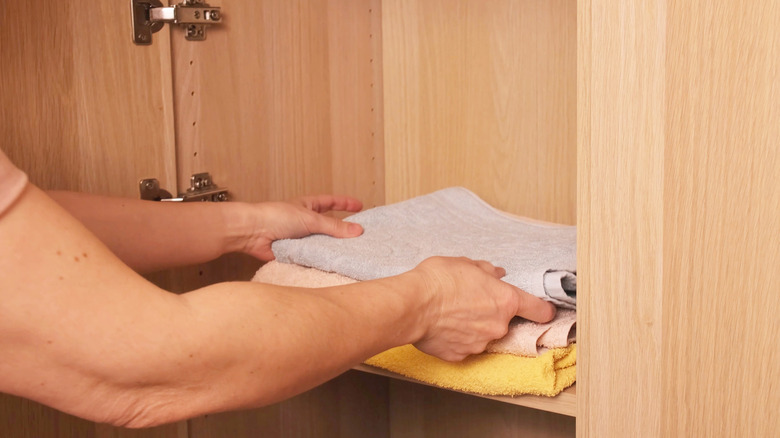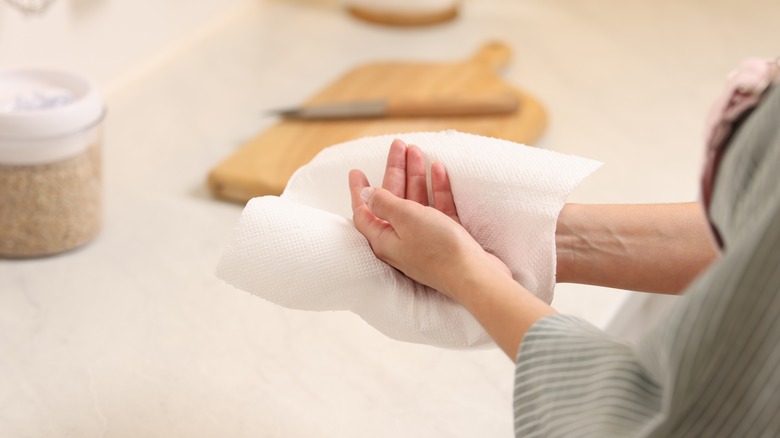The Type Of Towel To Avoid Using In Winter (It Can Get You Sick)
Winter pushes us indoors. We start spending more time in warm, crowded homes and tight spaces. Now, this sure feels cozy and comforting, but it is also a perfect opportunity for viruses, bacteria, and other diseases to spread from person to person. Indoor air and close quarters help these things spread, as they have nowhere else to go. Now you might think avoiding sneezers and handshakers will save you. But, unfortunately, you couldn't be more wrong. Germs will literally catch a ride on anything — even your cloth towels.
Cloth hand towels are basically just petri dishes in your home. They are warm, often moist, and they have plenty of spaces between the threads where germs can hide and divide. Every time someone touches a contaminated hand towel, they will either catch those germs or leave more germs behind — or both. This is exactly why hygiene experts will tell you not to use shared cloth hand towels.
Contaminated cloth towels can contain a very high number of microorganisms. And in the winter, when literally everyone seems to have the flu or another illness, that towel is basically sitting there like a germ Airbnb, happily welcoming the microbes and then passing them along. If you are not washing properly or replacing those cloth towels frequently enough, you are just inviting bacteria to stay in your home.
Why cloth towels make the perfect winter germ hotspot
Cloth hand towels are the worst troublemakers in the winter. They can make you sick as they stay wet for hours, since in the winter, things dry more slowly. And if you know anything about germs, they love moisture. This is true for both hand towels and bath towels. The ones used for drying dishes aren't safe either unless you are washing your kitchen towels all the time. In fact, tea towels are one of the biggest reasons for cross-contamination in homes. Bacteria cling to them and then just wait to be carried around.
Cloth towels can even develop complex biofilms of germs. If you don't know what biofilms are, they are just sticky colonies of pathogens clinging to something, which makes them persistent and more resistant to cleaning. And in winter, when everyone is congregating indoors and using the same bathroom, cloth towels become an efficient germ bridge. What is even more concerning is that cloth towels and other contaminated fabrics can harbor and transfer antibiotic-resistant bacteria, such as MRSA, between people and other surfaces.
Safer cloth towel habits for winter and what to use instead
Since cloth hand towels can act like germ shuttles, in places where a lot of hands are coming and going, such as the bathroom, it is almost always a better idea to use disposable towels. While you are at it, make sure to place trash or waste bins nearby for safe disposal. After all, there's no sense in using single-use hand towels if you are going to have to pick them up around your home, exposing yourself to all those microorganisms.
You can also try using warm-air or jet-air dryers, but the problem with them is that they create aerosols, which can contain germs. Disposable towels like paper towels don't have this problem. Now this is not to say that you cannot use a cloth towel at home at all during winter. If you keep them dry, wash them frequently, and replace them before they get mildewed, you should have less of a germ-transfer issue. Just wash them in hot water every week, and if they stay moist, maybe more often. Just make sure to avoid the mistakes everyone makes while washing their towels.


